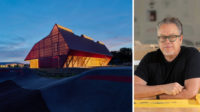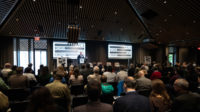On Wednesday, about 200 people convened at the French Institute/Alliance Française in Manhattan—with over a thousand more tuning in remotely–to learn about the future of design and urbanism from a robust line-up of architects speaking at RECORD’s annual Innovation Conference. Held in-person for the first time since 2019, the conference focused on the theme “Architecture and Its Alternatives.”
For architect Marlon Blackwell, who kicked off the day’s events with a talk titled “Radical Practice,” consideration of place and lived experience has always been essential to his design endeavors. Since founding his practice, Marlon Blackwell Architects, in Fayetteville, Arkansas in 1992, his portfolio has been marked by dramatic forms that draw inspiration in color and materiality from their environments, at a variety of scales and budgets. Recent Blackwell projects he discussed include the the Thaden School in Bentonville Arkansas and the Marygrove Early Education Center in Detroit.
OPEN Architecture’s Huang Wenjing, who is based in Beijing, also centered her talk around considerations of site and ecology, focusing on the early stages of the firm’s design process and emphasizing an ethos that fosters harmony between the built and natural worlds. For the UCCA Dune Art museum, on China’s coast east, she and her partner Li Hu grappled with the fragile landscape of sand dunes, ultimately embedding the 3,000 square-feet of galleries underground and preserving the dunescape. Other ventures she discussed were the Chapel of Sound (RECORD’s December 2021 cover) in a mountainous region of Hebei Province and a proposed scheme for the Shenzhen Maritime museum. Wenjing summed up her talk with a piece of advice from Confucius: “What we do not want to happen to ourselves, we should not inflict on others.”
A co-founder of the Turner Prize-winning collective Assemble, Paloma Strelitz discussed how her background in adaptive-reuse, installations and urban design has informed her current work as Creative Director at Patch, a startup that aims to facilitate coworking and other “spaces for community to gather and convene.” The work of Assemble ranges from transforming an old gas station into a movie house to creating the collective’s homebase, Sugarhouse Studios, which provides affordable studio space in east London. With Patch, Strelitz and her colleagues plan to prototype coworking and other community spaces so that neighborhoods and towns can improve work-life balance and reduce commuting.
2022 Architectural Record Women in Architecture Award winner Carol Ross Barney is known for public infrastructure projects in her beloved hometown of Chicago, especially the Chicago Riverwalk. Barney used her time to argue for the value of cities as beacons of efficiency and the importance of “healthy, equitable, sustainable infrastructure” within them. With the design for Chicago’s Morgan Street transit station, using durable polycarbonate, glass, or the Cermac-McCormick station’s steel perforated, shingle tube, Barney demonstrated how “the best solutions are integrated,” and emphasized the importance of community engagement in designing public infrastructure.
The only virtual presenter, architect Bjarke Ingels of Bjarke Ingels Group (BIG) began his talk on a global scale, discussing a myriad of environmental pressures, from carbon emissions and solar energy, to pipeline infrastructure and resource extraction. With lively graphics to make his points, he acknowledged some may find the firm’s broad approach to environmental concepts “megalomaniacal…but I believe that we can’t find a solution without thinking big first.” As examples of architecture based on this larger vision, Ingels presented the recently-completed Google Bay View Campus in California and a cross-shaped furniture factory in the Norwegian forest, which will generate 55 percent less emissions than a traditional factory, before imploring the audience to visit the firm’s website for its “Plan for the Planet,” which aims, he said, to be the “Wikipedia” of sustainability knowledge for designers.
Monica Rhodes, a previous Loeb Fellow at Harvard’s GSD and currently a fellow in historic preservation and conservation at the American Academy in Rome, has worked at the intersection of community engagement, public lands, cultural preservation, and philanthropy for over 15 years. She discussed her efforts to diversify and democratize the field of preservation, in which there are fewer than 15 BIPOC women working in the U.S. “What is preserved depends on who is at the table,” she said. By expanding the involvement of diverse groups, Rhodes challenges preservationists to “think expansively about what we preserve” and “engage with the past as we think about the future we want to see.”
Co-founders of Brooklyn-based SO – IL, Florian Idenburg and Jing Liu spoke about their “Berlin-style” philosophy of urbanism, which promotes greater spatial equity and more porous private-public enterprises. The most recent example in their work is 450 Warren in Brooklyn, a six-story, 18-unit complex with outdoor spaces, both common and private, distributed throughout. With units connected by concrete walkways, wrapped with flexible cable-nets, the project offers a new vision for multi-family housing beyond the blocky, uniform condos currently proliferating throughout Brooklyn. The partners also highlighted the porosity and functionality of the design of the Amant Arts Campus, also in Brooklyn.
In his talk, Tomas Rossant of Ennead Architects turned from design toward broader ideological concerns for the profession, discussing the shifting societal role of the architect. Comparing the two Renaissance-era Italian architects Filippo Brunelleschi (1377-1446), and Leon Battista Alberti (1404-72)—he nicknamed them Bruno and Al—Rossant traced how architects have, over time, limited themselves purely to the realms of form, theory, and design. He humorously argued for architects to take on a more expanded role once again, as Bruno did. Rossant used Ennead’s foray into affordable housing and partnership with start-up Juno to create off-site fabricated apartments to illustrate how architects can take on expanded roles to benefit both practice and the community.
Finally, 2022 Pritzker Laureate Francis Kéré took the stage for his only public speaking engagement in the Americas this year. He spoke of his childhood in Burkina Faso in west Africa and his first foray into architecture at the Technical University of Berlin. While still a student, he received the Aga Khan Award for Architecture for creating the Gando Primary School in his home village, bringing the community together to build it. That project and recent ones, such as the Startup Lions Campus in Kenya, define Kéré’s particular practice of vernacular architecture, which uses local materials—mud bricks, teak, eucalyptus—and traditional construction methods and has led to global acclaim and larger commissions, such as the national parliament in Benin, its design inspired by the idea of convening to debate under the shade of a large tree.
At the conclusion of the conference, RECORD’s Editor-in-Chief Cathleen McGuigan asked Kéré how winning the Pritzker has changed his life. “The phone is ringing non-stop,” he responded. Getting visibly emotional, he told the audience, “I wish this for all of you.” McGuigan asked if Kéré had any upcoming projects in the U.S., and the architect, without specifics, teased an affirmative.
If you missed the conference, on-demand video of the speakers will be available here by November 14th.







Post a comment to this article
Report Abusive Comment